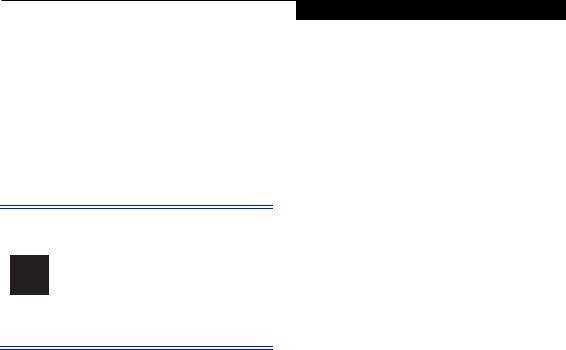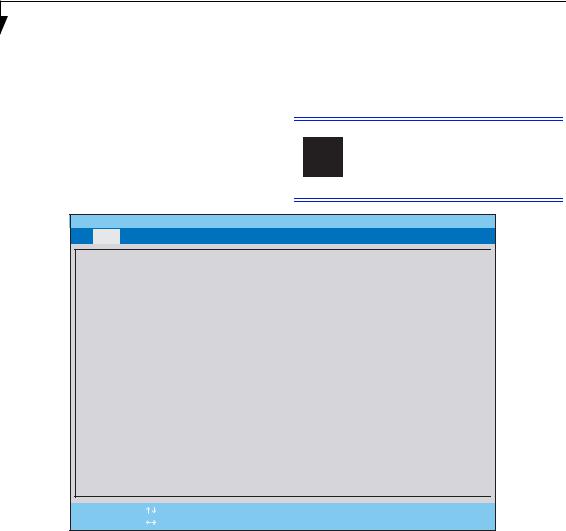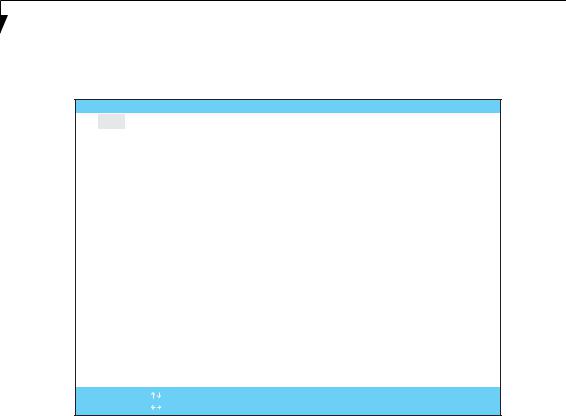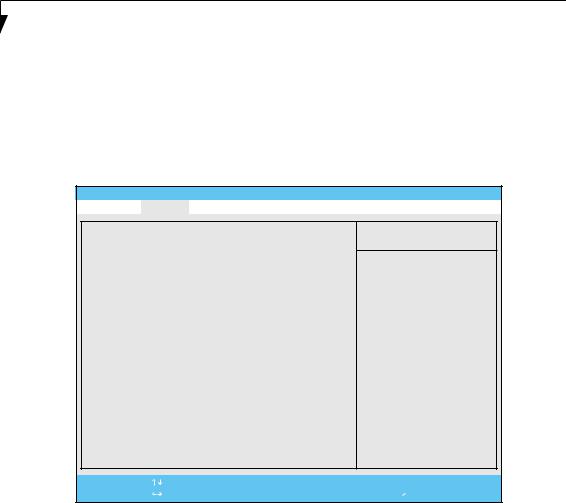Fujitsu LifeBook U810 BIOS Guide

Fujitsu LifeBook
U Series
BIOS Guide
LifeBook U Series Model:
U810
Document Date: 09/05/2007
Document Part Number: FPC58-1714-01
F U J I T S U C O M P U T E R S Y S T E M S C O R P O R AT I O N

L i f e B o o k U 8 1 0 N o t e b o o k B I O S
LifeBook U Series Notebook BIOS
BIOS SETUP UTILITY
The BIOS Setup Utility is a program that sets up the operating environment for your notebook. Your BIOS is set at the factory for normal operating conditions, therefore there is no need to set or change the BIOS environment to operate your notebook.
The BIOS Setup Utility configures:
■Device control feature parameters, such as changing I/O addresses and boot devices.
■System Data Security feature parameters, such as passwords.
Using the TrustedCore Menu
When the Fujitsu logo appears on the screen. press the [Enter] key or click on the left mouse or touchpad button; the TrustedCore Menu will appear.
The TrustedCore Menu provides shortcuts to the following menus and information screens:
■BIOS Setup
■Diagnostic Screen
■Boot Menu
■Diagnostic Program
■Patent Information
■System Information
■Continue Booting
The menu opens with BIOS Setup highlighted. Click the [Enter] button to open the BIOS Setup Utility.
The Boot Menu can also be invoked by pressing the [F12] key when the Fujitsu logo appears on the screen.
You can go directly to the BIOS Setup Utility by pressing the [F2] key once the Fujitsu logo appears on the screen. This will open the main menu of the BIOS Setup Utility with the current settings displayed.
Navigating through the Setup Utility
The BIOS setup utility consists of six menus: Main, Advanced, Security, Boot, Info, and Exit. This document explains each menu in turn, including all submenus and setup items.
The following procedures allow you to navigate the setup utility menus:
1. To select a menu, while holding the [Fn] button, use the left/right cursor keys:
2. To select a field within a menu or a submenu, while holding the [Fn] button, use the up/down cursor keys:
3.To select the different values for each field, press the [Spacebar] or [+] to change to the next lower selection and [F5] or [-] to go to the next higher selection.
4.To activate a submenu press the [Enter] key.
5.To return to a menu from a submenu, press the [Esc] key.
6.To go to the Exit menu from any other menu, press the [Esc] key.
■Selecting a field causes a help message about that field to be displayed on the right-hand side of the screen.
■Pressing the Enter key with the highlight on a selection that is not a submenu or auto selection will cause a list of all options for that item to be displayed. Pressing the Enter key again will select the highlighted choice.
7.Pressing the [Fn]+[F9] key resets all items in the BIOS to the default values.
8.Pressing the [Fn]+[F10] key saves the current configuration and exits the BIOS Setup Utility. You will be asked to verify this selection before it is executed.
9.Pressing the [Fn]+[F1] key gives you a general help screen.
Entering the Setup Utility After a Configuration Change or System Failure
If there has been a change in the system configuration that does not agree with the parameter settings stored in your BIOS memory, or there is a failure in the system, the system beeps and/or displays an error message after the Power On Self Test (POST). If the failure is not too severe, it will give you an opportunity to modify the setup utility settings, as described in the following steps:
2

M a i n M e n u
1.When you turn on or restart the computer there is a beep and/or the following message appears on the screen:
Error message - please run SETUP program Press <F1> key to continue, <F2> to run SETUP
2.If an error message is displayed on the screen, and you want to continue with the boot process and start the operating system anyway, press the [Fn]+[F1] key.
■If your notebook emits a series of beeps that sounds like a code and the display is blank, please refer to the Troubleshooting Section in the system User’s Guide. The Troubleshooting Section includes a list of error messages and their meanings.
■If your data security settings require it, you may be asked for a password before the operating system will be opened.
3.If an error message is displayed on the screen, and you want to enter the setup utility, press the [F2] key.
4.When the setup utility starts with a fault present, the system displays the following message:
Warning! Error message [Continue]
5.Press any key to enter the setup utility. The system will then display the Main Menu with current parameters values.
3

L i f e B o o k U 8 1 0 N o t e b o o k B I O S
MAIN MENU - SETTING STANDARD SYSTEM PARAMETERS
The Main Menu allows you to set or view the current system parameters. Follow the instructions for Navigating through the Setup Utility to make any changes.
The following tables show the names of the menu fields for the Main menu and its submenus, all of the options for each field, the default settings and a description of
the field’s function and any special information needed to help understand the field’s use.
System Time and System Date can also be set from your operating system without using the setup utility. Use the Date and Time utility on your Windows Control Panel.
Main Advanced
System Time:
System Date:
▲ Drive0
Language:
PhoenixBIOS Setup Utility |
|
|
|
|||
Security |
Boot |
Info |
Exit |
|||
|
|
|
|
|
Item Specific Help |
|
|
|
|
|
|
|
|
|
[14:57:01] |
|
|
|
|
|
[09/05/2007] |
|
|
|
|
||
[TOSHIBA MK4007GAL] |
|
|
Adjust calendar clock. |
|
||
|
|
|
|
|||
[English (US)] |
|
|
<Tab>, <Shift-Tab>, or |
|
||
|
|
<Enter> selects field. |
|
|||
|
|
|
|
|
|
|
|
|
|
|
|
|
|
F1 Help |
Select |
Item |
-/Space |
Change |
Values |
ESC Exit |
Select |
Menu |
Enter |
Select |
▲ Sub-Menu |
|
|
|
Figure 1. |
Main Menu |
|
Table 1: Fields, Options and Defaults for the Main Menu
F9 Setup Defaults
F10 Save and Exit
Menu Field |
Options |
Default |
Description |
|
|
|
|
System Time: |
–— |
–— |
Sets and displays the current time. Time is in a 24 hour format of |
|
|
|
hours:minutes:seconds with 2 digits for each. (HH:MM:SS). |
|
|
|
Example: 16:45:57. You may change each segment of the time separately. |
|
|
|
Move between the segments with the [Tab] key and/or [Shift] + [Tab] |
|
|
|
keys. |
|
|
|
|
System Date: |
–— |
–— |
Sets and displays the current date. Date is in a month/day/year numeric |
|
|
|
format with 2 digits each for month and day and 4 digits for year. (MM/ |
|
|
|
DD/YYYY) for example: 09/05/2007. You may change each segment of |
|
|
|
the date separately. Move between the segments with the [Tab] key and/ |
|
|
|
or [Shift] + [Tab] keys. |
|
|
|
|
4
|
|
|
|
|
M a i n M e n u |
|
|
|
|
|
|
|
|
Table 1: Fields, Options and Defaults for the Main Menu |
||||||
|
|
|
|
|
||
Menu Field |
Options |
Default |
Description |
|
||
|
|
|
|
|
||
Drive0: |
Selects the Drive0 |
The product |
Displays the type of device on this ATA/ATAPI interface, if there is one. |
|
||
|
Serial ATA drive |
number of |
Pressing the Enter key selects the Primary Master submenu allowing addi- |
|
||
|
submenu |
the hard |
tional device configuration options for this interface. |
|
||
|
|
|
drive. |
|
|
|
|
|
|
|
|
|
|
Language: |
■ |
English (US) |
[English (US)] |
The default setting differs between the US/European and the Japanese |
|
|
|
■ |
Japanese (JP) |
|
model. Selects the display language for the BIOS. |
|
|
|
|
|
|
|
|
|
5

L i f e B o o k U 8 1 0 N o t e b o o k B I O S
Drive0 Submenu of the Main Menu
The Drive0 submenu identifies which ATA devices are installed.
|
|
|
PhoenixBIOS Setup Utility |
|
|
|
||||
|
Main |
Advanced |
Security |
Power |
Boot |
Info |
Exit |
|||
|
|
|
|
|
|
|
|
|
||
|
|
Drive0 [TOSHIBA MK4007GAl] |
|
|
|
Item Specific Help |
|
|||
|
|
|
|
|
|
|
|
|
|
|
|
Type: |
|
|
|
|
|
|
Select Serial ATA/IDE |
|
|
|
|
|
[Auto] |
|
|
|
||||
|
|
|
LBA Format |
|
|
drive installed here. |
|
|||
|
Total Sectors: |
|
78140160 |
|
[Auto] |
|
||||
|
Maximum Capacity: |
|
40008MB |
|
|
|||||
|
|
|
|
|
|
|
|
The BIOS auto-types the |
|
|
|
Multi-Sector Transfers: |
[16 Sectors] |
|
drive on boot time. |
|
|||||
|
LBA Mode Control: |
|
[Enabled] |
|
[None] |
|
||||
|
Transfer Mode: |
|
[Multiword DMA 2] |
|
||||||
|
Ultra DMA Mode: |
|
[Disabled] |
|
The drive is disabled. |
|
||||
|
|
|
|
|
|
|
|
|
|
|
|
|
|
|
|
|
|
|
|
|
|
F1 Help |
Select |
Item |
ESC Exit |
Select |
Menu |
-/Space Change Values
Enter |
Select ▲ |
Sub-Menu |
F9 Setup Defaults
F10 Save and Exit
|
|
|
Figure 2. Drive0 Submenu |
|
Table 2: Fields, Options and Defaults for the Drive0 Submenu of the Main Menu |
||||
|
|
|
|
|
Menu Field |
Options |
Default |
Description |
|
|
|
|
|
|
Type: |
■ |
Auto |
[Auto] |
Select [Auto] to have the type of Serial or Parallel ATA device automatically |
|
■ |
None |
|
identified by the BIOS at POST. If [None] is selected, the following Set-up |
|
|
|
|
items do not appear. |
|
|
|
|
|
LBA Format |
|
|
|
Logical Block Addressing (LBA) |
|
|
|
|
|
Total Sectors: |
--- |
--- |
The total number of sectors on your hard disk. This information is automati- |
|
|
|
|
|
cally displayed when [Auto] is selected. |
|
|
|
|
|
Maximum |
--- |
--- |
The maximum capacity of your hard disk. This information is automatically |
|
Capacity: |
|
|
|
displayed when [Auto] is selected as the Type. |
|
|
|
|
|
Multi-Sector |
■ |
Disabled |
[16 Sectors] |
This information is automatically selected when [Auto] is selected as the Type. |
Transfers: |
■ |
2 Sectors |
|
|
|
■ |
4 Sectors |
|
|
|
■ |
8 Sectors |
|
|
|
■ |
16 Sectors |
|
|
|
|
|
|
|
LBA Mode |
■ |
Disabled |
[Enabled] |
Enables or disables logical Block Addressing in place of Cylinder, Head, Sector |
Control: |
■ |
Enabled |
|
addressing. This setting is automatically selected when [Auto] is selected as |
|
|
|
|
the Type. |
|
|
|
|
|
6
|
|
|
|
|
M a i n M e n u |
|
|
|
|
|
|
Table 2: Fields, Options and Defaults for the Drive0 Submenu of the Main Menu |
|||||
|
|
|
|
||
Menu Field |
Options |
Default |
Description |
||
|
|
|
|
|
|
Transfer |
■ |
Standard |
[Multiword |
Selects the method for moving data to/from the drive. This option cannot be |
|
Mode: |
■ |
Fast PIO 1 |
DMA 2] |
changed when Auto is selected and autotypes the drive to select the optimum |
|
|
■ |
Fast PIO 2 |
|
transfer mode. |
|
|
■ |
Fast PIO 3 |
|
|
|
|
■ |
Fast PIO 4 |
|
|
|
|
■ |
Multiword DMA 1 |
|
|
|
|
■ |
Multiword DMA 2 |
|
|
|
|
|
|
|
|
|
Ultra DMA |
■ |
Disabled |
[Disabled] |
Selects the method for moving data to/from the drive. This setting is auto- |
|
Mode: |
■ |
Mode 0 |
|
matically selected when [Auto] is selected and autotypes the drive to select |
|
|
■ |
Mode 1 |
|
the optimum transfer mode. |
|
|
■ |
Mode 2 |
|
|
|
|
■ |
Mode 3 |
|
|
|
|
■ |
Mode 4 |
|
|
|
|
■ |
Mode 5 |
|
|
|
|
|
|
|
|
|
Exiting from Main Menu
When you have finished setting the parameters on this menu, you can either exit from the setup utility, or move to another menu. If you wish to exit from the setup utility, press the [Esc] key or use the cursor keys to go to the Exit menu. If you wish to move to another menu, use the cursor keys.
7

L i f e B o o k U 8 1 0 N o t e b o o k B I O S
ADVANCED MENU - SETTING DEVICE FEATURE CONTROLS
The Advanced Menu allows you to:
■Select between the display panel and an external CRT display.
■Enable or disable compensation for your display.
■Configure CPU and USB features.
■Configure Miscellaneous features
The following tables show the names of the menu fields for the Advanced Menu and its submenus, all of the options for each field, the default settings and a description of the field’s function and any special information needed to help understand the field’s use.
PhoenixBIOS Setup Utility
Main |
Advanced |
Security |
Boot |
Info |
Exit |
▲ ▲ ▲ ▲ ▲ ▲
Keyboard/Mouse Features
Video Features
Internal Device Configurations
CPU Features
USB Features
Miscellaneous Configurations
Item Specific Help
Configures keyboard /mouse features
▲
Event Logging
F1 Help |
Select |
Item |
-/Space Change |
Values |
|
ESC Exit |
Select |
Menu |
Enter |
Select |
▲ Sub-Menu |
|
|
|
Figure 3. |
Advanced Menu |
|
F9 Setup Defaults
F10 Save and Exit
Table 3: Fields, Options and Defaults for the Advanced Menu
Menu Field |
Description |
|
|
Keyboard/Mouse |
When selected, opens the Keyboard/Mouse Features submenu, which allows setting NumLock to Off, On, or On/ |
Features |
Padlock Off. |
|
|
Video Features |
When selected, opens the Video Features submenu, which allows setting of the display parameters, including |
|
routing of video signals to different displays. |
|
|
Internal Device |
When selected, opens the Internal Device Configurations submenu, which allows enabling or disabling the IDE, |
Configurations |
LAN, and modem controllers. |
|
|
CPU Features |
When selected, opens the CPU Features submenu, which allows configuration of Intel SpeedStep Technology |
|
performance features and enables or disable XD Bit functionality. |
|
|
USB Features |
When selected, opens the USB Features submenu, which allows enabling or disabling USB and SCSI Subclass sup- |
|
port. |
|
|
8
|
|
A d v a n c e d M e n u |
|
|
|
Table 3: Fields, Options and Defaults for the Advanced Menu |
||
|
|
|
Menu Field |
Description |
|
|
|
|
Miscellaneous |
When selected, opens the Miscellaneous Configurations submenu, which allows you to change the power button, |
|
Configurations |
Wake Up On LAN, Volume settings, video memory size, hardware power management, and power-on LED illumi- |
|
|
nation. |
|
|
|
|
Event Logging |
When selected, opens the Event Logging submenu which lets you view and enable the event log. |
|
|
|
|
9
